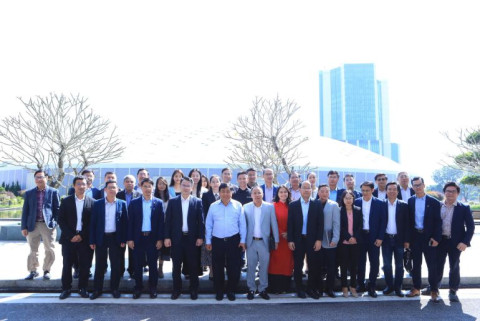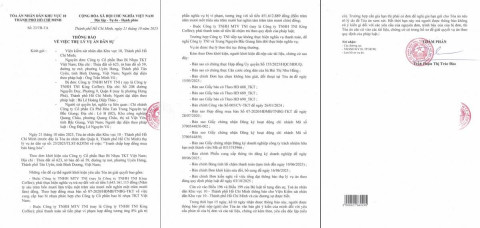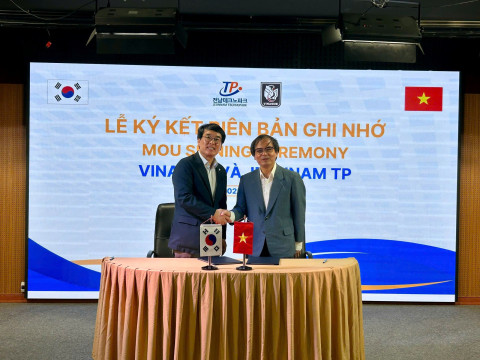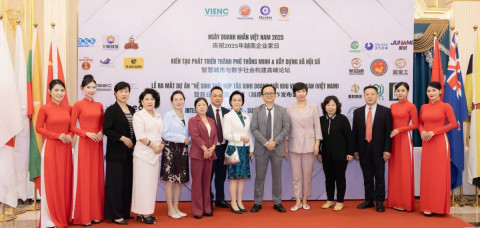Green transition helps Vietnam’s textile industry increase its competitiveness in the international market
- 141
- Business
- 13:43 02/05/2024
DNHN - The transition to green production and business is a major trend. Accordingly, the Vietnamese textile industry is no exception, applying sustainable solutions and green transition will help increase its competitiveness in the international market.
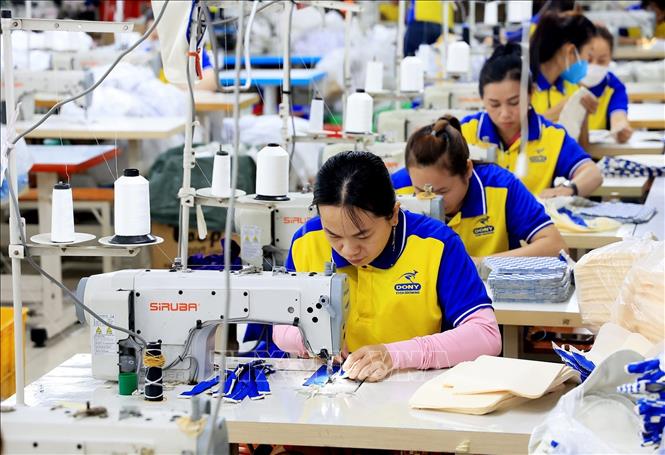
Enhancing image and reputation in the international market
One of the important benefits of green transition is creating a sustainable production and business system, which is beneficial for both businesses and the environment. The Vietnamese textile industry has realised that minimising the negative impact on the environment and resources will help improve production efficiency and create high-quality products. The use of recycled raw materials, water-saving management, and energy-saving use play an important role in reducing carbon emissions and waste during the production process. This not only helps reduce the impact on the environment but also enhances the image and reputation of the Vietnamese textile industry in the international market.
The green transition also creates opportunities for the Vietnamese textile industry to develop high-value-added products and meet the demands of demanding markets. In the international market, more and more consumers are interested in buying environmentally and socially friendly products. By applying green standards and sustainable certifications, the Vietnamese textile industry can create safe, non-polluting products that comply with regulations on labour rights and social security. This helps the Vietnamese textile industry capture trends and increase its competitiveness in the international market.
To apply green transition in the Vietnamese textile industry, support and commitment from businesses, the government, and related organisations are needed. Businesses can invest in advanced technologies to minimise environmental impact while ensuring compliance with green standards. The government can promote the development of supportive policies, encourage investment in green technology infrastructure, and provide funding and tax incentives for businesses implementing green transition. Related organisations can provide guidance and assessment to support the Vietnamese textile industry in applying green standards and sustainable certifications.
In addition, building cooperative relationships with international partners is also very important. By participating in global supply chains and adhering to green standards, the Vietnamese textile industry can increase the trust and reliability of international partners. This opens up opportunities to access new markets, expand production scale, and increase revenue.
Green transition in the textile industry is necessary
The Vietnamese textile industry has made significant progress in the green transition and increasing its competitiveness in the international market. Leading businesses in the industry have implemented measures such as using recycled raw materials, strengthening water and energy management, and improving working conditions. The products of the Vietnamese textile industry have also been recognised and highly appreciated for their quality and sustainability in the international market.
However, there is still much work to be done. Businesses in the textile industry need to continue investing in research and development of green technologies, raise awareness of environmental protection and labour rights, and strengthen cooperation with international partners. The government needs to orient and promote supportive policies and create favourable conditions for green transition in the textile industry.

According to Mr Tran Thanh Hai, Deputy Director of the Import and Export Department (Ministry of Industry and Trade), the Vietnamese textile industry will have to compete with 104 export markets, including markets such as Africa, Russia, India, etc., so the green transition in the garment industry is very necessary.
“For example, Bangladesh, thanks to greening the supply chain, has successfully attracted a large number of orders in 2023. This country has up to 153 LEED-certified factories (energy and environmental design orientation) and currently has 500 factories are currently applying for this certification,” said Mr Hai.
In general, green transition plays an important role in increasing the competitiveness of the Vietnamese textile industry in the international market. By applying sustainable solutions and adhering to green standards, the industry can not only create high-quality products but also meet the increasing demands of demanding markets for the environment and society.
Nghe Nhan
Related news
- Connecting Leaders, Shaping the Future: Strategic Leadership Planning Meeting – CorporateConnections Hanoi A
- Sunlight - Unilever Vietnam Recognized for Outstanding Contributions to the National Initiative Supporting Women Entrepreneurs
- Deputy Prime Minister Nguyễn Chí Dũng: “The country’s major challenges weigh heavily on my mind — and we must resolve them together.
- Unitsky String Technologies signs cooperation agreements with three Vietnamese partners, opening a new direction for smart mobility and sustainable development
- When artists do business – livelihood is no poetry!
- Before the D‑day to abolish flat‑rate tax: Fear of technology and costs leave small traders struggling to adapt
- Vietnamese enterprises at a crossroads: the impact of a potential US–China deal
- "Digital technicians" must not be forgotten if Vietnam aims to meet its strategic goals
- HDBank: Impressive profit growth, leading in profitability and advancing international integration
- TNI King Coffee sued for over VND 5 Billion in unpaid debts
- VINASME and Jeonnam Technopark Sign MOU on technology cooperation, human resource training, and trade promotion
- Vietnamese entrepreneurs strengthen ASEAN connectivity in the digital iIntegration era
- Prime Minister: Vietnam aims to become a regional logistics hub
- Vietnam upgraded to Secondary Emerging Market by FTSE Russell
- Hanoi’s economy grows 7.92% in first nine months of 2025, FDI surges nearly threefold
- Vietnam’s strong gdp growth fails to ease labor market distress
- US tariffs on Brazil propel Vietnam’s pangasius into global spotlight
- VietLeap AI Accelerator launches: A strategic springboard for Vietnam’s AI startups
- CICON expands strategic alliances: A new step forward in Vietnam–Korea business connectivity
- What must Vietnamese enterprises do to maintain their position in the global supply chain?
Đọc thêm Business
Connecting Leaders, Shaping the Future: Strategic Leadership Planning Meeting – CorporateConnections Hanoi A
"Your network is your most powerful flowing asset. It generates value, multiplies opportunities, and accelerates your influence across borders."
Innovative ESG enterprise: Trạm Xe Việt startup proposes solutions to build a green mobility ecosystem
As Vietnam commits to achieving Net Zero by 2050 and tightens emissions standards, the transportation sector faces unprecedented pressure to transform.
Deputy Prime Minister Nguyễn Chí Dũng: “The country’s major challenges weigh heavily on my mind — and we must resolve them together.
On the morning of November 26, 2025, Deputy Prime Minister Nguyễn Chí Dũng chaired a high-level working session at the National Innovation Center (NIC) in Hòa Lạc.
Unitsky String Technologies signs cooperation agreements with three Vietnamese partners, opening a new direction for smart mobility and sustainable development
The signing ceremony took place in Minsk, Belarus, on November 28, 2025.
Before the D‑day to abolish flat‑rate tax: Fear of technology and costs leave small traders struggling to adapt
From 1 January 2026 the flat‑rate tax regime will be abolished. Small business households will be required to declare tax based on actual revenue. MISA supports the transition with technology to help micro‑merchants adapt smoothly and transparently.
Vietnamese enterprises at a crossroads: the impact of a potential US–China deal
As the world closely monitors every shift in US-China relations, emerging signals of a strategic agreement between the two global powers are raising hopes for global economic stability.
HDBank: Impressive profit growth, leading in profitability and advancing international integration
Ho Chi Minh City Development Joint Stock Commercial Bank (HDBank, stock code HDB) announced its consolidated profit before tax for the first 9 months of 2025 reached VND 14,803 billion, marking a 17% increase year-on-year (YoY).
TNI King Coffee sued for over VND 5 Billion in unpaid debts
On October 21, 2025, the People’s Court of District 10 in Ho Chi Minh City officially accepted a civil lawsuit concerning a commercial contract dispute between TKT Vietnam Plastic Packaging Joint Stock Company and TNI King Coffee Co., Ltd.
VINASME and Jeonnam Technopark Sign MOU on technology cooperation, human resource training, and trade promotion
On October 15, 2025, in Hanoi, VINASME and Jeonnam Technopark (Korea) signed an MOU to promote trade, advance technology transfer, and develop human resources between enterprises of both nations.
Vietnamese entrepreneurs strengthen ASEAN connectivity in the digital iIntegration era
On the occasion of Vietnam Entrepreneurs’ Day (October 13), an international event themed “Integration – Innovation – Sustainable Development” was solemnly held in Ho Chi Minh City.




